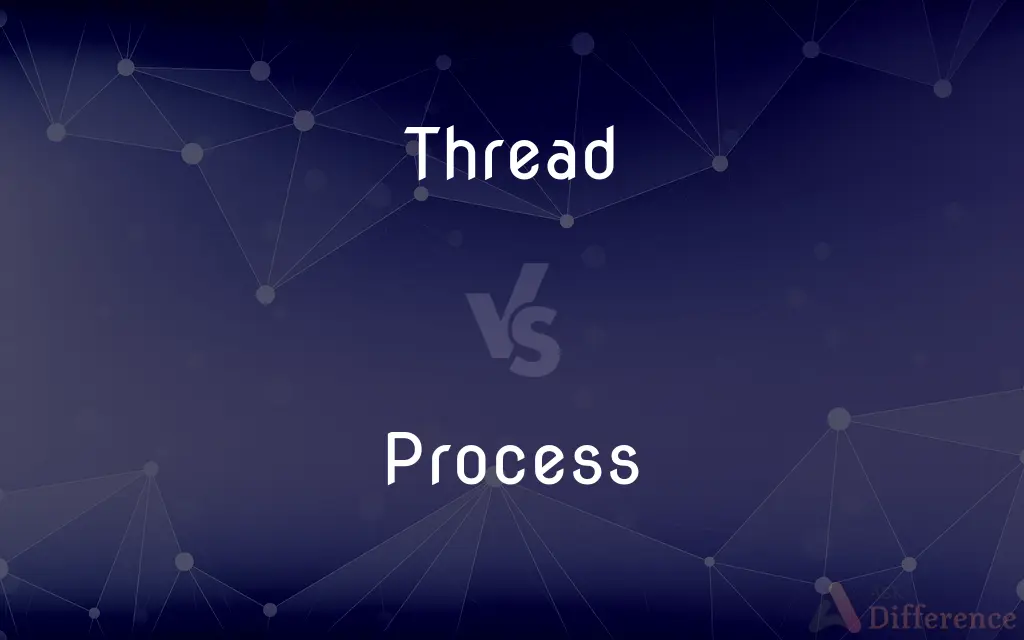Thread vs. Process — What's the Difference?
By Tayyaba Rehman & Fiza Rafique — Updated on March 21, 2024
A thread is a sequence of executable commands that can run concurrently within a process, while a process is a complete program in execution, including its code, data, and system resources.

Difference Between Thread and Process
Table of Contents
ADVERTISEMENT
Key Differences
A process is an instance of a program running in a computer's operating system, having its own memory space, system resources, and scheduling. It serves as a container for one or more threads, which are the smallest units of execution that the operating system can schedule. Each thread within a process shares the process's resources, such as memory and file handles, but can execute independently, allowing for parallel execution of tasks within the same process.
Threads are designed to allow concurrent operations within a single process, making efficient use of CPU resources by performing multiple tasks at the same time. Since threads within the same process share the same memory space, they can communicate with each other more efficiently than processes, but this also means that a fault in one thread can affect the entire process.
Processes are isolated from each other, providing a higher level of security and stability, as faults or crashes in one process do not directly impact others. This isolation requires more resources, however, as each process needs its own memory space and system resources. Communication between processes (inter-process communication, or IPC) is possible but more complex and resource-intensive than communication between threads.
Creating a new process involves duplicating the parent process's resources and allocating new ones, which is more resource-intensive and slower than creating a new thread. On the other hand, creating a thread is faster and less resource-intensive, as it only needs to allocate memory for the stack of the new thread within the existing process's memory space.
The choice between using multiple threads or multiple processes depends on the requirements of the application, including considerations of performance, security, and complexity. Multi-threading is suitable for tasks that require shared memory and are closely related, while multi-processing is better for tasks that need to be isolated from each other or that require full utilization of multi-core processors without the risk of shared memory conflicts.
ADVERTISEMENT
Comparison Chart
Definition
The smallest unit of execution within a process.
An instance of a program running in the operating system.
Resource Sharing
Shares memory and resources with other threads in the same process.
Has its own memory space and system resources.
Communication
Easier and faster, as threads share the same memory.
More complex and slower, requires IPC mechanisms.
Creation Overhead
Lower, as it only involves creating a stack space within an existing process.
Higher, involves duplicating resources and allocating new ones.
Isolation
Limited, as an error in one thread can affect the entire process.
High, as processes are independent of each other.
Use Case
Suitable for tasks that require concurrent execution within the same application.
Suitable for tasks that require isolation and security between different applications.
Compare with Definitions
Thread
Used for fine-grained parallelism within an application.
A server application using threads to handle multiple client connections at the same time.
Process
Suitable for distributed systems and multitasking.
An operating system running multiple applications in separate processes for isolation and security.
Thread
Lightweight, sharing the process's resources.
Threads in a word processor may handle spell-check, auto-save, and user input concurrently.
Process
Independent, with its own memory space.
Two different processes cannot directly access each other's memory without IPC.
Thread
Efficient inter-thread communication.
Threads in a game sharing game state information for rendering and logic processing.
Process
Uses IPC for process communication.
A database server process communicating with a web server process via sockets.
Thread
Susceptible to issues like deadlocks.
Two threads waiting on each other to release resources can freeze a program.
Process
An executing instance of an application.
Running multiple instances of a spreadsheet application, each as a separate process.
Thread
A path of execution within a process.
A web browser using multiple threads to handle user interface, file downloads, and network communication simultaneously.
Process
More robust to faults.
A crash in one process does not affect the stability of another process.
Process
(Computers) To perform operations on (data).
Process
(computing) An executable task or program.
Common Curiosities
How is a thread different from a coroutine?
Threads are managed by the operating system, while coroutines are cooperatively multitasked tasks managed by the user-level application, allowing for more fine-grained control of execution flow.
Why use multiple processes instead of threads?
Multiple processes provide better isolation and stability, as faults in one process do not affect others, making it a better choice for applications that require reliability and security.
What is the overhead of creating a thread vs. a process?
Creating a thread has lower overhead because it shares the process's resources, while creating a process requires duplicating some resources and allocating new ones, making it more resource-intensive.
What mechanisms are used for thread synchronization?
Common mechanisms include mutexes, semaphores, and condition variables, which help manage access to shared resources and coordinate thread execution.
What is multi-threading?
Multi-threading is the ability of a CPU or a single core in a multi-core processor to provide multiple threads of execution concurrently.
Can threads of different processes communicate?
Directly, no, because they reside in separate memory spaces. However, they can communicate through IPC mechanisms like sockets, shared memory, or message queues.
How do threads share data?
Threads share data through shared memory within the same process, allowing for efficient communication but also requiring synchronization to avoid conflicts.
Can a process exist without threads?
No, a process must have at least one thread, known as the main thread, to execute any tasks.
What is a thread pool?
A thread pool is a collection of pre-instantiated, idle threads which can be used to perform multiple tasks in the background, improving performance by reusing existing threads instead of creating new ones.
How does the operating system schedule threads and processes?
The operating system schedules threads and processes based on scheduling algorithms, considering priorities, fairness, and the need to avoid starvation, to efficiently use CPU time and resources.
Share Your Discovery

Previous Comparison
Dogma vs. Doctrine
Next Comparison
Paint vs. DyeAuthor Spotlight
Written by
Tayyaba RehmanTayyaba Rehman is a distinguished writer, currently serving as a primary contributor to askdifference.com. As a researcher in semantics and etymology, Tayyaba's passion for the complexity of languages and their distinctions has found a perfect home on the platform. Tayyaba delves into the intricacies of language, distinguishing between commonly confused words and phrases, thereby providing clarity for readers worldwide.
Co-written by
Fiza RafiqueFiza Rafique is a skilled content writer at AskDifference.com, where she meticulously refines and enhances written pieces. Drawing from her vast editorial expertise, Fiza ensures clarity, accuracy, and precision in every article. Passionate about language, she continually seeks to elevate the quality of content for readers worldwide.













































